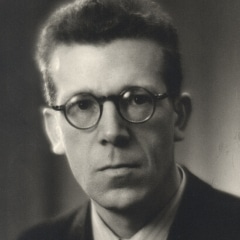درخودماندگی (اوتیسم) چیست ؟
هیچ یک تجربه از اوتیسم وجود دارد.
روشن ترین تعریف این است که اوتیسم-بالینی به عنوان اختلال طیف اوتیسم (ASD) نامیده می شود-یک روش متفاوت تفکر ، یک تفاوت تحولی عصبی است که تغییر نحوه ارتباط شما با محیط و افرادی که در اطراف شما است.
به عبارت ساده ، اوتیسم تغییر راه که می بینید ، تجربه و درک جهان است.
جهان به تمام انواع ذهن نیاز دارد.
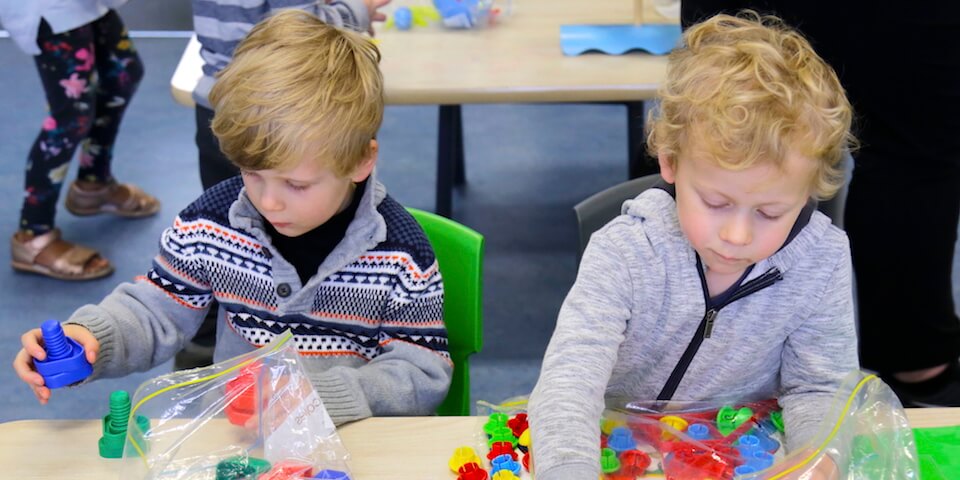
طیف اوتیسم چیست ؟
You might have heard people referring to autism as a ‘spectrum’. This is used to emphasize that there is an infinite number of ways that autism can be experienced.
While people on the autism spectrum share a range of similar characteristics, there are an equal number of differences between individuals, so the experience of autism varies greatly from person to person.
دکتر استفان ساحل استاد autistic از آموزش و پرورش ویژه در دانشگاه Adelphi ، نیویورک ، آن را بهترین زمانی که او گفت:
"اگر شما یک فرد مبتلا به اوتیسم را ملاقات کرده اید ، شما یک فرد مبتلا به اوتیسم را ملاقات کرده اید."
The support needs of autistic individuals can range vastly from person to person. Some individuals may want or need ongoing support in daily living, community participation, communication, while other individuals may desire little or no support in these or other areas.
While every individual has strengths and challenges, some of the key strengths identified in people on the autism spectrum at a higher rate than the general population include:
- بودن جزئیات گرا;
- شناسایی بی نظمی;
- به عنوان یک متفکر منطقی ؛
- absorb and retain facts;
- tenacity and resilience;
- visual learners;
- in-depth knowledge in specific areas;
- honest, loyal and committed;
- حفظ تمرکز بر روی یک کار ؛ و
- دیدن چیزها از یک دیدگاه متفاوت.
It is important to remember that these are generalised strengths, and that many individuals on the autism spectrum do not have a strength in one or many of these areas and may in fact find some of these areas challenging.
تفاوت های من معلوم شد همچنین شامل هدایایی که من مجموعه ای از هم جدا.
Many individuals on the autism spectrum can find enjoyment in routine and predictability, or engaging in a particular passion, activity or hobby. This can mean that people on the spectrum may be highly successful in their chosen careers or hobbies.
Just like there are some common strengths associated with the autism spectrum, there are a range of some common challenges that people on the autism spectrum may face. Some of these challenges can include:
- communicating wants, needs and desires;
- social interaction and interpreting other people’s behaviour or feeling that others do not understand their behaviours;
- پردازش اطلاعات حسی; یا
- پردازش اطلاعات شناختی.
Individuals on the spectrum may develop skills in a way that is different from those that are not autistic. This can include the order in which skills are developed, the extent to which skills develop, and how skills develop. Skill development again, will vary significantly from individual to individual.
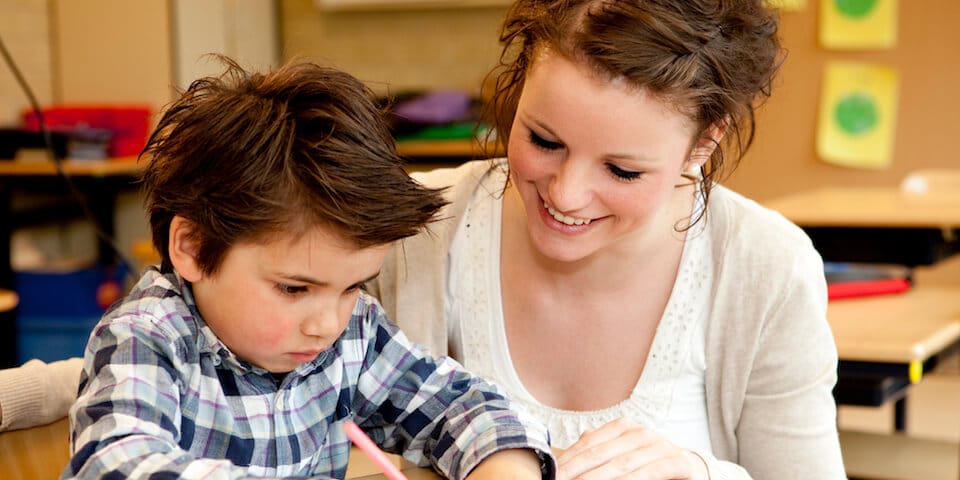
What are the characteristics of autism?
The characteristics of autism can vary widely in nature and presentation from person to person, and can also develop, change and improve over time.
Age, and cognitive ability can also influence how the characteristics of autism present themselves in different people, which is something that should also be considered.
While much of the diagnostic process is related to behavioural attributes, it can be difficult to diagnose autism until they are between 18-20 months. For some, the signs of autism may not become apparent until school years, or adult years when demands exceeds capacity.
با این وجود ، اگر احساس می کنید که شما ، فرزند شما یا کسی که دوست دارید در طیف اوتیسم است ، ممکن است بخواهید فرآیند تشخیصی را شروع کنید.
وقتی که من ملاقات با افراد مبتلا به اوتیسم ، متوجه شدم که چقدر من به آنها مربوط ، آن را به من متوجه شدم که این همان چیزی است که آن را مانند برای هر فرد دیگری تمام وقت است.
As autism is a varied spectrum of characteristics it can be difficult to identify if a person is autistic. To help you better understand the characteristics here is a summary of what to look out for, according to the latest diagnostic guidelines, the DSM-5.
علائم در دوره رشد
- In order to be diagnosed on the autism spectrum, characteristics must have been present in the early developmental period of a person’s life. It can be difficult to pick up on characteristics of autism for many parents, as raising a child in something that is very new to most people. For parents that already have a child diagnosed, they may be more aware of the early charateristics of autism so they pick up on these earlier.Or for other parents that have an older child that is not autistic, they also may pick up on the early characteristics of autism earlier as their children are developing differently. See our characteristics of autism in children checklist page for more information.
- For many adults, they many only become aware of the characteristics of autism in relation to their own behaviours later in life. When they then think back over their life they may start to identify how autism may have impacted their life at different moments such as realising that others seemed to know what others were thinking when they found it difficult to read people’s emotions. Many autistic adults have learnt strategies to support their challenges throughout their lifetime. It is therefore important to think about what characteristics were present at a young age when seeking a diagnosis as an adult. See our characteristics of autism in adults checklist page for more information.
To be diagnosed with an Autism Spectrum Disorder an individual does not need to have difficulties in all areas but rather must meet a specific combination of criteria across two domains. It is important to keep in mind that this is just a short summary, and that only trained, accredited professionals can make a formal autism diagnosis.
دامنه A: ارتباطات اجتماعی و تعامل اجتماعی
تفاوت و یا چالش های مربوط به زبان و ارتباطات اجتماعی و تعامل اجتماعی در زمینه های مختلف ، هم اکنون یا از لحاظ تاریخی. این خدمات عبارتند از مشکل و یا تفاوت در:
- ارتباطات اجتماعی-عاطفی و مبادلات شخصی.
- رفتارهای غیر کلامی ارتباطی برای تعامل اجتماعی استفاده می شود.
- توسعه ، حفظ و درک روابط.
دامنه B: رفتار تکراری یا محدود ، علایق یا فعالیت ها
محدود ، الگوهای تکراری از رفتار ، منافع و یا فعالیت در حداقل دو نفر از موارد زیر است:
- حرکات موتور تکراری ، استفاده از اشیا یا گفتار.
- اصرار بر همه چیز یکسان ، انعطاف ناپذیر و مصر بر روال و یا الگوهای رفتاری کلامی یا غیر کلامی است.
- Engage in passions, activities or hobbies with a great focus and which can bring intense enjoyment; and
- Unexpected reactions, to sensory input, or an unusual interest in sensory aspects of the environment.
تاثیر عملکردی اوتیسم بر روی یک فرد
For some people autism can impact all areas of life significantly, while for others it can impact certain aspects of life to a lesser degree. Because of this, autism is referred to as a “spectrum” and diagnosed based on both characteristics and the impact that these differences may have on a person’s life over time.
If the characteristics shown by a person are causing significant challenges in social, personal, family, occupational or other important areas of a person’s life then it is likely that the person will be diagnosed with an Autism Spectrum Disorder.
If the characteristics are not having a negative impact on a person’s life or relationships, and they are able to engage in all social and interpersonal settings, it’s unlikely that autism will be diagnosed.
رفتارهای خاص که به تصرف معیارهای ذکر شده در بالا و درجه که آنها زندگی روزمره را تحت تاثیر قرار متفاوت بین افراد و می تواند تحت تاثیر عوامل مانند سن, یادگیری و پشتیبانی در دسترس. با توجه به این تنوع, DSM5 فراهم می کند سطح شدت 1 به 3 برای هر یک از دو حوزه به منعکس کننده درجه که رفتار آنها جذب دخالت در زندگی روزمره فرد نیاز به پشتیبانی.
توجه: مهم است به یاد داشته باشید که این سطح شدت یک تصویر لحظهای از عملکرد در زمان تشخیص است و ممکن است در طول زمان به عنوان مهارت های توسعه و/یا تغییرات تقاضا تغییر.
این سه سطح ، و ویژگی ها و پشتیبانی نیاز دارد که آنها را تعریف می کند ، در DSM-5 ذکر شده است:
- سطح 1: "نیاز به پشتیبانی"
- سطح 2: "نیاز به حمایت قابل توجه"
- سطح 3: "نیاز به پشتیبانی بسیار قابل توجه"
While Autistic Disorder, Asperger’s Disorder and Pervasive Developmental Disorder Not Otherwise Specified (PDD-NOS) are no longer diagnosed as a separate disorder under the current diagnostic criteria (DSM-5), a person with a pre-existing diagnosis under the previous diagnostic criteria (DSM 4) can continue to use their pre-existing diagnosis.
سندرم اسپرگر رنج می برد ؟
In 1994 Asperger’s Syndrome appeared as a separate presentation of a pervasive developmental disorder in standard diagnostic manuals.
ویژگی های کلیدی سندروم اسپرگر شناخته شده در آن زمان:
- مشکلات با تعامل اجتماعی و ارتباطات اجتماعی
- رفتارهای محدود و تکراری
- بدون کم توانی ذهنی
- بدون تاخیر در توسعه گفتار کلامی
در ماه مه ۲۰۱۳ ، معیارهای تشخیصی اوتیسم با انتشار آخرین راهنمای تشخیصی (DSM 5) تغییر کرد.
Since then “Autistic Disorder” and “Asperger’s syndrome” are no longer differentiated as separate presentation of pervasive developmental disorders, but are now included under the single diagnosis of Autism Spectrum Disorder (ASD) or referred to as autism.
هویت و عزت نفس مثبت
اوتیسم من دلیل من در کالج و موفق است. این دلیل من در ریاضی و علوم خوب است. این دلیل من مراقبت است.
People on the autism spectrum have strengths, skills and passions and often achieve great things, for themselves, their community and our world.
For some people a diagnosis of autism can enhance their self-identity and further develop their awareness of what makes them unique – autism becomes a positive part of their identity.
Many successful people in our community are autistic, some significant discoveries, developments and achievements have been made by autistic people, and without this neurodiversity in our society we certainly would not have achieved some of our greatest leaps in understanding about our culture, societies, communities and our world.
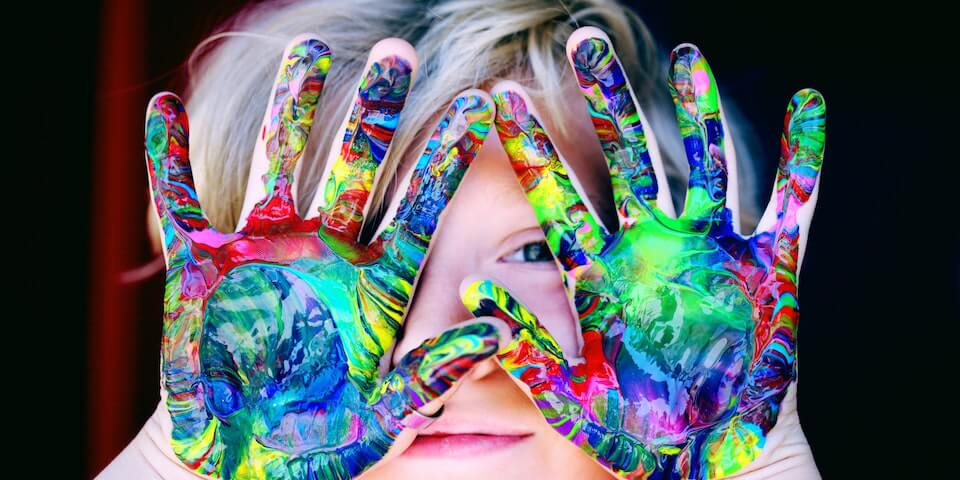
جنبش نوروگوناگونی
من متفاوت است ، نه کمتر.
Neurodiversity was first coined in the mid-1900s by the Australian Sociologist, Judy Singer who recognised that “neurologically diverse (people) needed a movement of their own”, and that voicing “differences in neurology should be recognised and respected.”
The neurodiversity movement is a social and advocacy initiative that recognises and values this, based on the preference that neurological differences as natural variations in the human brain. Originating from the autistic rights movement, it now encompasses a range of neurological differences such as ADHD, dyslexia, and Tourette’s Syndrome. This movement is celebrated and important for several reasons.
The movement acknowledges neurological diversity as an essential and natural aspect of human diversity, similar to gender, ethnicity, sexual orientation, or disability. The movement challenges the traditional view that treats neurological differences as disorders or deficiencies, the movement promotes a more accepting approach which is why it is so celebrated.
The movement also advocates for inclusivity and acceptance in society, urging changes in education, employment, and social policies to cater to diverse neurological needs to benefit all.
The movement empowers neurodivergent individuals, encouraging self-determination and the right to advocate for oneself and highlights the unique strengths and abilities of neurodivergent individuals, instead of focusing solely on challenges and limitations.
With its introduction and gaining of momentum, the neurodiversity movement’s significance in Australia and globally lies in its ability to foster a more inclusive society that respects and supports all forms of human variation, enabling individuals with neurological differences to live respected and fulfilling lives.
شیوع اوتیسم چیست ؟
شیوع دقیق اوتیسم در استرالیا و بین المللی ناشناخته است.
However, international prevalence research indicates that around 1% of the international population have an autism diagnosis of sorts. While some countries report higher rates, such as the USA (around 1:59), other countries report much lower prevalence rates.
Data from the Australian Bureau of Statistics (ABS), 2022 Disability, Aging and Carers, Australian: Summary of Findings shows that:
- the number of Australian diagnosed as autistic has increased over the past decade, from 164,00 in 2015, 205,200 in 2018 and 290,900 in 2022
- around nine out of ten people diagnosed as autistic are under the age of 25.
- 1 out of 2.2 Australian diagnosed as on the autism spectrum are female
The Australian Bureau of Statistics (ABS) is due to release more updated data on the autism prevalence in Australia in mid 2024.
در حالی که شیوع گزارش شده از اوتیسم در سراسر جهان متفاوت است ، شده است وجود دارد افزایش روشن در تعداد افراد مبتلا به طیف اوتیسم در سال های اخیر ، اما این لزوما نشان می دهد که بیشتر مردم autistic در جهان وجود دارد از وجود دارد ده یا بیست سال پیش بودند.
شواهد نشان می دهد که افزایش نتیجه تعدادی از عوامل فرهنگی و بالینی است, از جمله تأثیرات اجتماعی رانندگی آگاهی بیشتر از اوتیسم, و بهبود روش های تشخیصی و تغییرات در معیارهای تشخیصی اجازه می دهد افراد بیشتری برای دسترسی به تشخیص.
According to Professor Whitehouse, from Australia’s Autism CRC, research shows the majority of the increase in autism prevalence over this period was due to an increase in diagnosing children with less complex behaviours.
"ما اکنون می دانیم که وضعیت ارائه در امتداد طیف. این مهم است که ما همه از طیف گسترده ای از سخنرانیها ، و همچنین نقاط قوت قابل توجهی است که افراد در طیف را به جامعه ما آگاه است ، "پروفسور Whitehouse گفت.
اوتیسم در استرالیا
Autism is a neurological difference, a different way of thinking. The word ‘spectrum’ reflects the diversity of autistic people and how characteristics present. There is not one single cause of autism. The following is an overview of autism in Australia at the time of publication.
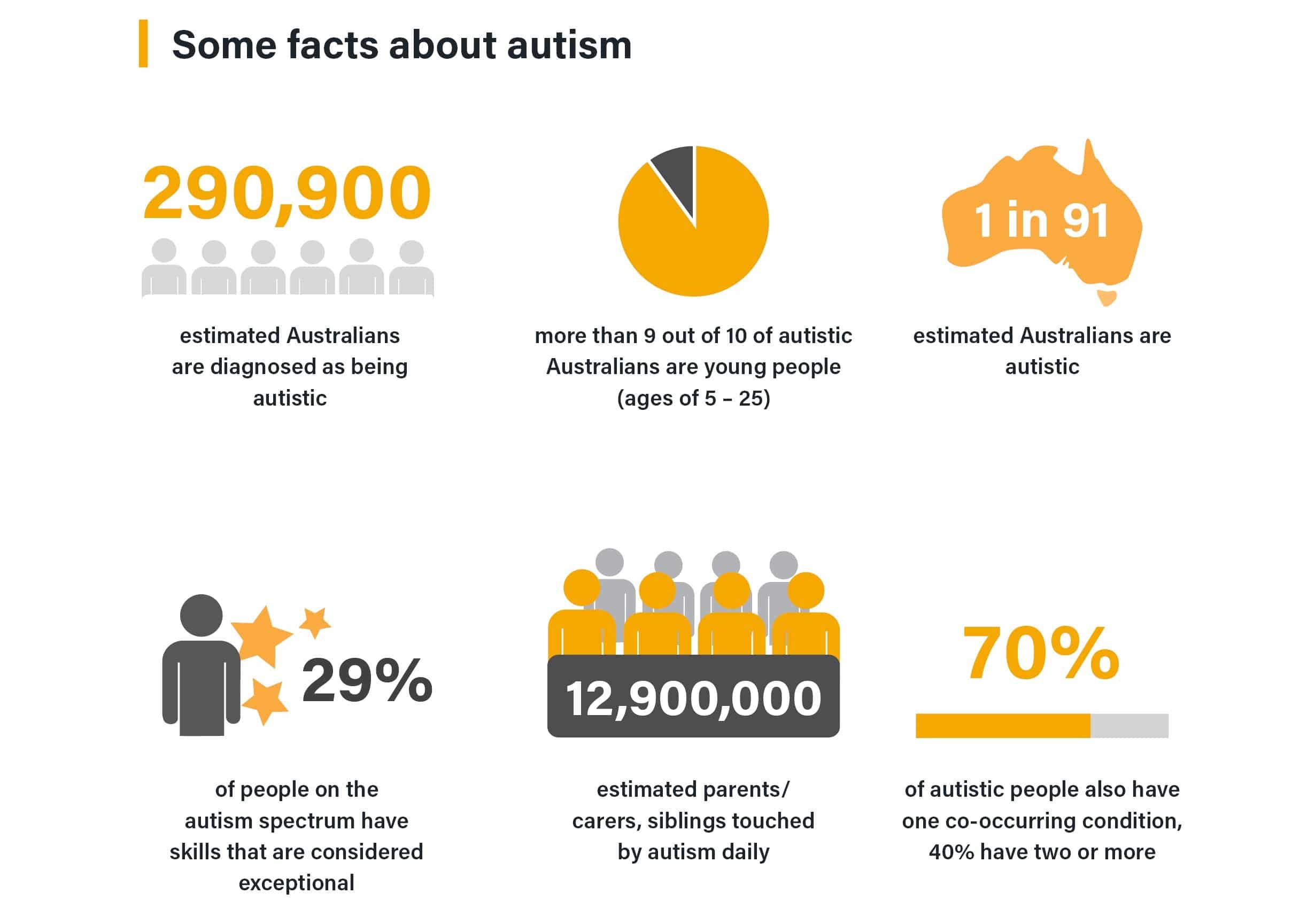
Sources:
• Australian Bureau of Statistics (2022). Disability, Ageing, and Carers, Australia: Summary of Findings. [https://www.abs.gov.au/articles/autism-australia-2022.]
• Australian Bureau of Statistics (2018). Disability, Ageing and Carers, Australia: Summary of Findings [https://www.abs.gov.au/statistics/health/disability/disability-ageing-and-carers-australia-summary-findings/latestrelease#
autism-in-australia]
• Australian Bureau of Statistics (2015). Disability, Ageing and Carers, Australia: Summary of
Findings, 2015 [https://www.abs.gov.au/ausstats/abs@.nsf/Previousproducts/4430.0Main%20
Features762015?opendocument&tabname=Summary&prodno=4430.0&issue=2015&num=&view=]
• Clark, T., Jung, J. Y., Roberts, J., Robinson, A., & Howlin, P. (2023). The identification of exceptional skills in school age autistic children: Prevalence, misconceptions and the alignment of informant perspectives. Journal of Applied
Research in Intellectual Disabilities, 36(5), 1034–1045. https://doi.org/10.1111/jar.13113
• Whitehouse AJO, Evans K, Eapen V, Wray J. A national guideline for the assessment and diagnosis of autism spectrum disorders in Australia. Cooperative Research Centre for Living with Autism, Brisbane, 2018.
تاریخچه اوتیسم چیست ؟
The understanding of autism has developed over a number of decades. While the term ‘autism’ was defined by Kanner, there is varying evidence that other professionals, including Grunya Efimovna Sukhareva and Paul Bleuler, had recognised the unique presentation of characteristics much earlier than this. Since the 1940’s the diagnostic criteria has evolved and shifted as we learn more but now autism is widely understood as a spectrum of conditions with wide-ranging degrees of presentation.
1943
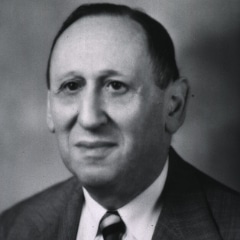
1944
A year later, Hans Asperger, a paediatrician at the University of Vienna in Austria wrote an article about children he had observed who shared similar characteristics of those in Kanner’s clinic but on a wider spectrum.
However, it has been suggested that Asperger and colleagues in Vienna had in fact been analysing and describing autism since the 1930s and that colleagues of Asperger actually played a key role in Kanner’s work in the 1940s.
Part of Asperger’s approach was to create a school that was centred around these children’s cognitive strengths rather than any perceived difficulties they faced.
What was notable was the diversity of the characteristics displayed by the children in Asperger’s clinic – an aspect of autism about which we have begun to have a greater understanding in recent years.
As Asperger’s research work was undertaken during the years in which Austria was under control of Nazis, his article was not translated into English for nearly forty years. So that, his findings did not become widely accessible until 1981.
1981
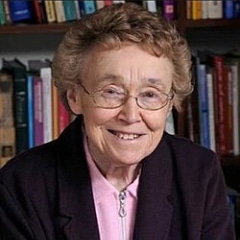
1989
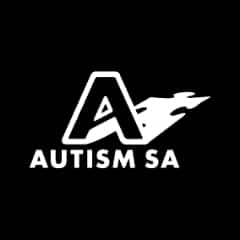
1994
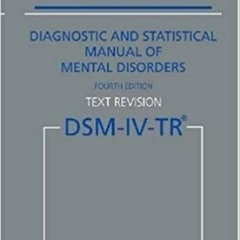
1996

2013
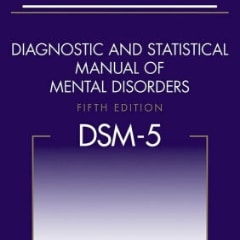
چه عواملی باعث اوتیسم?
تحقیقات قابل توجهی است که در سراسر جهان به علل اوتیسم انجام, و در حالی که مطالعات پیشنهاد کرده اند تعدادی از انجمن ها و ارتباط های احتمالی, علل اوتیسم هنوز هم تا حد زیادی ناشناخته.
در حالی که تحقیق در مورد علل اوتیسم به طور مداوم در حال تحول است ، ما نمی دانیم که این احتمال وجود دارد که یک علت منفرد از اوتیسم وجود نداشته باشد ، بلکه اوتیسم ناهمگن است ، به این معنی که تعدادی از علل اوتیسم وجود دارد. تحقیقات همچنین نشان داده است که به احتمال زیاد به تعدادی از عوامل مؤثر که منجر به تفاوت های عصبی ما به عنوان اوتیسم و یا طیف اوتیسم تشخیص وجود دارد.
ژنتیک
محققان بسیاری از ژن های ممکن است که ممکن است نقش در توسعه اوتیسم بازی پیدا کرده اند, که منجر به اعتقاد به اوتیسم است که در واقع تعدادی از شرایط مختلف است که همه نشانه های رفتاری نسبتا مشابه و ویژگی های.
Research supports that for groups of autistic people, there are genetic differences across a range of genes or specific genes that cause neurological differences, which means that they display autistic characteristics.
Research into family genetics and the prevalence of autism has supported this finding. Research has shown that if there is one person in the family diagnosed as autistic, it can increase the likelihood that others in the family will also be on the autism spectrum, at the following rates:
- خاله, عمو, عموزاده (2-3%)
- خواهر و برادر و دوقلوها غیر یکسان (10 ٪)
- یکسان دوقلوها ۸۰ ٪ اگر کسی تشخیص داده شود
For some groups of autistic individuals, it appears that the genes are passed on from a parent directly, for others, genes from both parents are combined, meaning that they are likely to cause neurological differences resulting in autism, while for other individuals there may be genetic differences that have not been passed on, but have arisen during fetal development.
For a number of autistic people there are clear genetic variations that have shown to be the cause of their neurological difference, while for many other people diagnosed there appears to be no significant genetic differences.
Ultimately this means that while genetics seems to be the clear cause for some types of autism, either through de novo or genetic variations, at this stage they do not explain the cause of everyone’s autism.
دیگر عوامل موثر که در حال حاضر به دلیل توانایی خود را برای نفوذ در توسعه عصبی تحقیق عبارتند از:
- وزن کمتر از تولد و تولد زودرس
- Advanced paternal age at time of conception
Research has identified that every individual on the autism spectrum has different neurology to each other, further supporting the notion that autism is a spectrum of conditions. While there have been a range of research studies into these areas, more research is needed.
There has been significant research into what does not cause autism. It is clear that autism is not caused by vaccines, bad parenting or the food we eat.
حقایق در مورد تصورات غلط رایج و اوتیسم
آیا شما در پیدا کردن که به معنی خانواده و دوستان ، مفسران رسانه ها حتی برخی از متخصصان بهداشت و درمان شما بیشتر نگران و اشتباه در مورد خود و یا اوتیسم فرزند شما و یا اوتیسم مشکوک ؟
اطلاعات غلط و پیام های مختلط می تواند به احساس گناه و انزوا منجر شود و می تواند در برابر یک برنامه تشخیص و پشتیبانی فعال کار کند. اگر چه درک جهانی از اوتیسم به طور مداوم در حال تحول است ، در اینجا برخی از حقایق معمولا درک ، برای کمک به برخی از این تصورات غلط در مورد اوتیسم به رختخواب قرار داده است.
علل اوتیسم چه هستند ؟
طبیعی است که بداند چه عواملی باعث اوتیسم می شود ، اما احتمال دارد که یک علت منفرد وجود نداشته باشد. در حالی که تفاوت های ژنتیکی شناخته شده به علت برخی از انواع اوتیسم ، علل اوتیسم تا حد زیادی ناشناخته است.
We do know that autism is a neurobiological difference, meaning that the brain processes information differently for autistic people, than it does for people who are not autistic.
ما همچنین می دانیم که سبک های فرزندپروری یک کودک برای توسعه اوتیسم ایجاد نمی کنند.
درخودماندگی (اوتیسم) توسط واکسیناسیون در طول یا قبل از بارداری ایجاد نمی شود ، و ارتباط دروغ گزارش شده بین سرخک-اوریون-سرخجه (MMR) واکسناسیون و اوتیسم از مقاله ای که در آن منتشر شد ، و به طور کامل توسط تحقیقات بی اعتبار شد ، جامعه علمی و پزشکی.
برای کسب اطلاعات بیشتر در مورد مطالعات فعلی که به علل اوتیسم انجام شده است ، به ما مراجعه کنید علل بخش اوتیسم.
اوتیسم چگونه تشخیص داده می شود ؟
Fortunately, the way autism is assessed has changed and improved over the last 80 years.
We now recognise a wider range of characteristics as forming part of the autism spectrum.
As awareness increases, parents and professionals are getting better at identifying early characteristics of autism and are more likely to seek an autism assessment.
This contributes to the explanation as to why people think autism is more prevalent today than it was ten or twenty years ago.
برای اطلاعات بیشتر در مورد تشخیص به ما چگونه می توانید از صفحه تشخیص اوتیسم بروید.
Do autistic people all look and act the same?
Autistic people are part of the diversity that is humanity, where no-one person is the same as another.
تحقیقات تکمیل شده تا آنجا که 1940s نشان داد که اوتیسم طیف از رفتارها و مهارت است.
برای کسب اطلاعات بیشتر در مورد رفتارهای مربوط به اوتیسم ، از صفحه علائم و ویژگی های ما دیدن کنید.
Are autistic people physically or intellectually disabled?
Autistic people do not look different to other people and are usually physically healthy.
Autism is not an intellectual disability although some autistic people may also be diagnosed with an intellectual disability.
Do autistic people communicate?
Everyone communicates. Many autistic people communicate using speech. For some people the way speech sounds may be unique including using a mono tone, very formal language for the context in which it is used or use an accent. For others, verbal speech might be delayed or many not develop. It is important to develop ways that a person can communicate their needs to those around them.
من می توانم نا امیدی که قادر به صحبت کردن به یاد داشته باشید. من می دانستم که آنچه که من میخواستم بگویم ، اما من می توانم کلمات را دریافت نمی کنم ، بنابراین من فقط جیغ.
برخی از افراد از سیستم های ارتباطی جایگزین مانند زبان اشاره ، سیستم های تبادل تصویر یا تکنولوژی کمکی برای برقراری ارتباط با کسانی که در اطراف آنها هستند استفاده می کنند.
Do autistic people have emotions?
Autistic people feel the same emotions as their parents, family or friends. People on the autism spectrum may express and feel emotions in a way that is different to people that are not autistic. They may have difficulties in expressing their emotions in a way that non-autistic people understand or recognise- this can cause frustration.
Some autistic people may shout or hit out when distressed but this is usually a reaction or last resort when there is a difficulty in communicating.
It is common for autistic people to have difficulty recognising and interpreting the emotions of others- know as alexithymia-, but many individuals develop strong bonds with important people in their lives such as parents and siblings like everyone else.
برای برخی از افراد, روش های معمول نشان دادن محبت می تواند مشکل تر, مانند حفظ چشم زل نگاه کردن و تماس فیزیکی.
برای کسب اطلاعات بیشتر در مورد رفتارهای مربوط به اوتیسم ، از صفحه علائم و ویژگی های ما دیدن کنید.

Do autistic people make friends?
Most autistic people often do want to have friends, but have difficulty engaging socially with others or knowing how to recognise and respond to the intentions and emotions of others, particularly towards non-autistic people. This is known as the double empathy theory.
Understanding how people interact and engage with others is complex and is generally required to form friendships. Many autistic people report that they find this difficult to understand and navigate and often seek supports and services to support their ability to make and maintain relationships, including romantic relationships, relationships at work and social relationship. Planned activities around shared interests are often the key to supporting the development and maintenance of friendships.
برای کسب اطلاعات بیشتر در مورد رفتارهای مربوط به اوتیسم ، از صفحه علائم و ویژگی های ما دیدن کنید.
آیا اوتیسم می تواند درمان شود ؟
اوتیسم نمی تواند بیشتر "درمان" از رنگ چشم ، زمین از صدا ، ارتفاع خود را و یا به شکل پای خود را.
Early diagnosis and support can help individuals to develop skills necessary for a full, productive and satisfying life.
People who say they or their children were ‘cured’ may have been particularly successful in acquiring skills which enable them to become more effective through their everyday life.
بسیاری از افرادی که تشخیص اوتیسم در مورد مفهوم "درمان" اوتیسم نگران هستند ، به عنوان آنها احساس می کنند که آنها اوتیسم است که آنها را می سازد ، آنها است. بسیاری از مردم کمک موفقیت خود را به قادر بودن به در یک راه کاملا متفاوت فکر می کنم پس از آن اکثریت قریب به فرد از مردم که به طور معمول توسعه.
این درک جشن اوتیسم توسط افراد در طیف اوتیسم به نام جنبش neurodiversity نامیده می شود.
برش موضوع اوتیسم
With an increased awareness of autism in our society you may start to recognise the characteristics of people you know or love as “on the spectrum” or “autistic”.
While it’s exciting that people are becoming more aware of the full spectrum of autism, it’s important for people to also be sensitive about the language they use surrounding it, and when approaching autistic people.
قبل از اینکه موضوع اوتیسم را با فردی که ممکن است مبتلا به اوتیسم باشد (یا خانواده های آنها) بالا ببرید ، مهم است که موارد زیر را در نظر بگیرید:
- چرا فکر می کنید مهم است که موضوع را با یک شخص بالا ببرید ؟
- نتایج مثبت بالقوه به عنوان مثال پشتیبانی و درک ، و یا بهبود خود آگاهی و هویت چیست ؟
- What are the potential negatives e.g. denial, confusion.
- ممکن است لازم باشد برای پذیرش پاسخ منفی و حمایتی و غیر قضاوت آماده باشید.
- چه کسی ممکن است بهترین فرد برای بالا بردن موضوع--به عنوان مثال ممکن است بهتر از یک عضو خانواده یا دوست مورد اعتماد می آید.
- چه تن شما استفاده می کنید ؟ بدیهی است ، شما باید احترام و حساس است.
- اجتناب از دادن مشاوره خاص
- در مورد خدمات پشتیبانی که ممکن است قبل از مکالمه مفید باشد ، اطلاعات بیشتری کسب کنید.
- Remember that you are NOT likely to be in a position to diagnose, unless you are trained to do so. You can raise the topic, and suggest the person or family member seeks more information on autism from a recognised and qualified professional.
برای کسب اطلاعات بیشتر درباره طیف اتیسم ، به صفحه علائم و ویژگی هایما مراجعه کنید.




